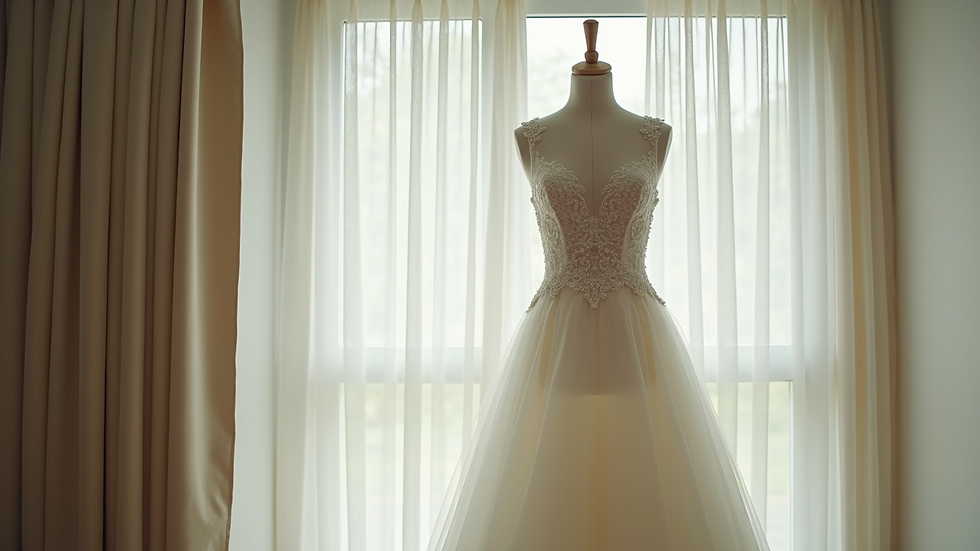Everything You Need to Know About Wedding Dress Alterations
- Romantic Dreams Bridal

- Jul 21
- 5 min read
Getting engaged is an exhilarating moment in life, and for many, finding the perfect wedding dress is one of the highlights of the wedding planning process. However, once you find that dream gown, you may discover that it requires some alterations to achieve the perfect fit. This comprehensive guide will walk you through everything you need to know about wedding dress alterations, including types of alterations, costs, and tips to prepare for your fitting.
Gown Alteration Guide
The journey of altering a wedding dress starts with understanding your specific needs. Whether your dress is too big, too small, or simply doesn’t match your vision, there are various types of alterations that can be performed. Some common alterations include:
Taking In or Letting Out: This is one of the most common adjustments. If your gown is too loose, the seamstress will take it in at the seams. If it’s too tight, they can let it out, assuming there's enough fabric.
Hem Adjustment: Whether your dress is too long or too short, hem adjustments can help tailor the length to your height. This is crucial for ensuring that you don’t trip on your gown while walking down the aisle.
Strap Adjustments: If your dress has straps, adjusting their length can help achieve a better fit. This can also prevent the dress from slipping off your shoulders.
Bustle Creation: For dresses with trains, a bustle allows you to lift the back of your gown for dancing and moving around comfortably after the ceremony.
Modifications: Sometimes, you may want to change the style of your dress, such as adding sleeves or changing the neckline. Talk to your seamstress about what is feasible.
Understanding these alterations can help you communicate better with your seamstress and get the look you desire.

How to Prepare for Dress Fitting
Preparing for your dress fitting is just as important as the fitting itself. Here are some actionable steps:
Bring Your Shoes: Wear or bring the shoes you plan to wear on your wedding day. This ensures that the dress is hemmed to the correct length.
Wear Proper Undergarments: The right undergarments can significantly change how the dress fits. Consider wearing the same type of lingerie you plan to have on during your wedding day.
Bring Inspiration Photos: If you have specific styles or modifications in mind, bring photographs that illustrate your vision.
Consider Accessories: If you plan to wear a veil, jewelry, or other accessories, bring them along. Accessories can impact how the dress fits and looks.
Being well-prepared can enhance your fitting experience, ensuring that your dress comes out exactly how you envision it.
How Much Can a Wedding Dress Be Altered?
The extent to which a wedding dress can be altered really depends on the construction and design of the gown. In most cases, a wedding dress can be altered in several significant ways; however, there are limitations.
General Limitations
Minimum Fabric: If your dress is very fitted and constructed with a small amount of fabric, you may be limited in how much it can be let out. A good rule of thumb is to check for extra fabric in the seams before making any decisions.
Style and Structure: Some styles, like fitted mermaid gowns, may have less flexibility compared to flowy A-line dresses with more give.
Average Cost
The cost of alterations can vary widely depending on factors such as:
Location: Different regions will have different price points.
Complexity: Simple hemming will cost less compared to major modifications like adding a bustle or altering the structure dramatically.
On average, you may expect to spend anywhere from £100 to £350 for alterations, depending on the intricacy of the adjustments. Always discuss the costs upfront with your seamstress to avoid surprises, and any bespoke or custom pieces are always extra.

Finding the Right Seamstress
Finding the right seamstress for your wedding dress alterations is crucial. Here are steps to help you choose wisely:
Research: Look online for reviews and recommendations. Websites and social media pages often provide insight into previous customers' experiences.
Experience in Bridal Alterations: Ensure that your chosen seamstress has experience specifically with wedding dresses, as they require different techniques and understanding than standard clothing.
Consultations: Schedule a consultation before committing. During this meeting, ask questions about their process, timelines, and any previous work.
Bring the Dress: In your initial meeting, if possible, take your wedding dress along. This helps the seamstress assess the work needed and give you a more accurate estimate.
Why Experience Matters
An experienced seamstress will be better at making adjustments that preserve the original beauty of the dress while ensuring it fits you perfectly. Additionally, they may offer creative solutions that you hadn’t thought of, enhancing the dress more than basic alterations would.
The Fitting Process
The fitting process usually involves multiple appointments. Below is a general timeline for what to expect:
First Fitting: At the initial fitting, the seamstress will take your measurements, assess the dress, and discuss potential alterations. This is also when you can try on the dress with the proper undergarments and shoes.
Second Fitting: After the initial adjustments have been made, the second fitting is where you'll see a significant difference. This might be the time to work on small adjustments, like the hem and strap length.
Final Fitting: This is the last fitting before your big day. The dress should fit perfectly, and any last-minute adjustments can be made. It is also a time to ensure the bustle is functioning properly.
Don’t be afraid to speak up during fittings. It's essential that you feel comfortable and confident in how the dress looks and feels.

Final Considerations
Adjusting your wedding dress can seem daunting but is essential to achieving your desired look. Always keep in mind:
Timing: Start alterations at least two to three months before your wedding to allow for multiple fittings and adjustments.
Budget: Factor alterations into your overall dress budget. It’s better to plan ahead than to be surprised later.
Trust Your Seamstress: Once you’ve found the right professional, trust their expertise. They can guide you on what is possible and what isn’t.
With the proper knowledge and preparation, your gown alterations can be a positive and exciting part of your wedding planning journey. The effort you invest will ensure you walk down the aisle feeling breathtaking and confident in your dream dress.




Comments